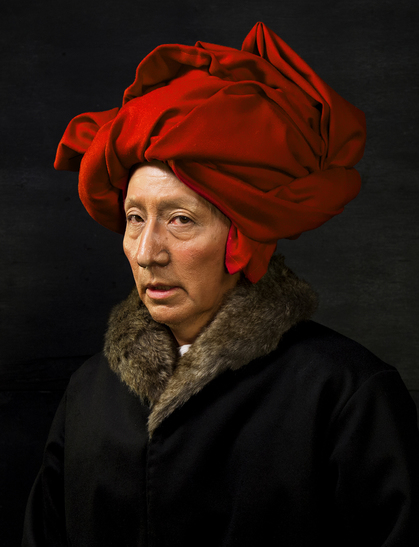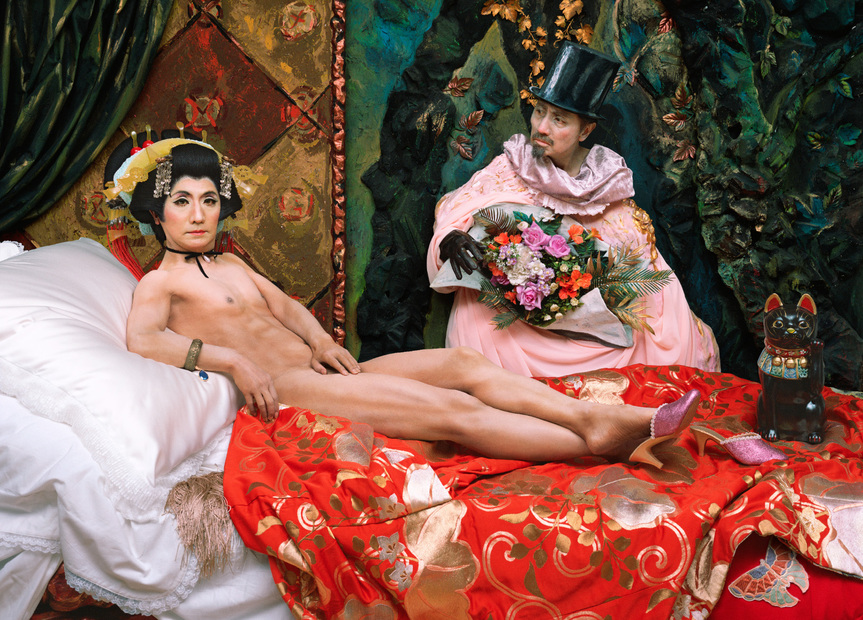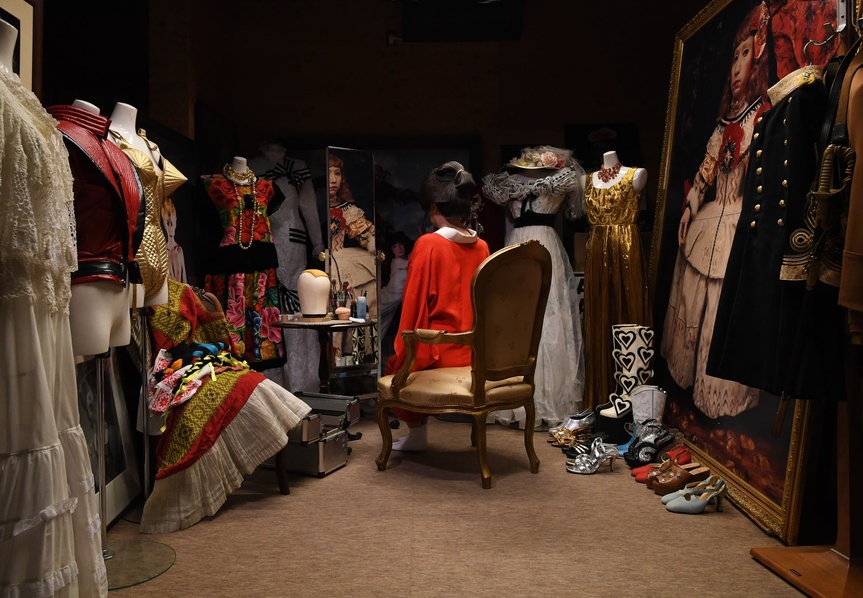-
From Current Issue
-
- Editor’s Letter Fire in the Heart
- Reviews I Gusti Ayu Kadek Murniasih
- Reviews 11th Seoul Mediacity Biennale: “One Escape at a Time”
- Dispatch Networked China
- One on One Monira Al Qadiri on Yukio Mishima
- Essays The rise of independent art spaces in pandemic-era Shanghai
- Features Tuan Andrew Nguyen
- Table of Contents
- Web Exclusives
- Archive
- Subscribe

R
E
V N
E
X
T
Installation view of YASUMASA MORIMURA’s “Ego Obscura” at Japan Society, New York, 2018. Photo by Richard Goodbody. Copyright and courtesy Japan Society.
A portrait gallery of sorts introduced Yasumasa Morimura’s solo exhibition “Ego Obscura” at Japan Society. In the dimly lit gallery, over 30 portraits gazed back at the viewer, who may have been led to believe that they had wandered into a collection of Western art’s greatest masterpieces. Yet it’s not quite Jan van Eyck’s or Leonardo da Vinci’s likenesses that appear in the frame of Van Eyck in a Red Turban and What Leonardo’s Face Says (both 2016). It is the face of Morimura, made up and manipulated to mimic these artists. By photographing himself in elaborate costumes and sets, the Japanese artist re-enacts famous works of art, including the aforementioned prints both from Morimura’s series “Self-Portraits Through Art History” (2016).
Born in 1951, Morimura came of age in the post-World War II era heavily influenced by American culture and education. His incarnation of figures from Johannes Vermeer to Vincent van Gogh, Frida Kahlo to Andy Warhol, speaks to that legacy. But it also becomes a way for the Japanese artist to see himself reflected in a Western-dominated art history. In composing Caravaggio’s David with the Head of Goliath (circa 1610), he assumed the role of the young hero as well as that of slain giant, resulting in his work Two Caravaggios / David Painting Goliath (2016). He transformed himself into Rembrandt at nearly every stage of life in a succession of self-portraits completed in 1994. In Vermeer Study: A Great Story Out of the Corner of a Small Room (2004), he stands in as both the painter and the subject. Like Vermeer’s The Art of Painting (1665–1668), Morimura’s recreation serves as metacommentary about the nature of his own practice. He invents narratives and stories for many of these pieces in the accompanying feature-length video, Egó Sympósion (2016).
By inserting himself into such iconic images, Morimura also comments on the mutability of identity. He pays particular attention to the construction of gender and race in his repeated iterations of Edouard Manet’s Olympia (1863). In the earlier version entitled Portrait (Futago) (1988), Morimura attempted a faithful homage by donning a woman’s wig and accessorizing with jewelry matching those visible in the source. Of course, what remains most prominently on display is his naked form, just as the reclining nude prostitute takes center stage in Manet’s painting. Yet, even as he adorns and surrounds his body with feminine objects, he does not disguise its masculine appearance.
Complementing the white model in the original work, a black model dressed as a maid looks on beside her, a part played by Morimura in blackface. The uncomfortable process of racialization additionally extends to a moment of self-Orientalizing. Morimura reprised the role of the demi-mondaine in Une moderne Olympia (2018). But this time, instead of embodying a white woman, he exchanged the blonde coiffure for a black headpiece that evokes the Western fantasy of the stereotypical geisha. Gone, too, is the black maid, who has been replaced by a European-styled man wearing a top hat, representative of the white male gaze.
This gendered dynamic between a feminized East and dominant West comprises a major component of the show that culminates with the titular Egó Obscura (2018). The 51-minute-long film includes a scene where Morimura performs a dance dressed as a geisha to a song from Puccini’s Madama Butterfly. The scene is reminiscent of David Henry Hwang’s 1988 play M. Butterfly, inspired by the same opera. The number follows a shot of the artist standing in front of the print A Requiem: Unexpected Visitors / 1945, Japan (2010), which reimagines the first meeting between General Douglas MacArthur and Emperor Hirohito. The Japanese government had banned the use of the original photograph because of how it depicted the emperor as being overshadowed by the American’s larger stature. In Morimura’s photo, they meet at his father’s tea shop as a way of layering the globally historical moment upon the artist’s biography. Other self-portraits as Japanese writer and director Yukio Mishima and Hollywood icon Marilyn Monroe, two symbols of Japan and the US respectively, further illustrate the duality of the artist’s consciousness. As Morimura acknowledged, “The two—my own personal history and the bigger picture—they may seem to be very different but in reality they are very much intertwined.”
Mimi Wong is a New York desk editor of ArtAsiaPacific.
Yasumasa Morimura’s “Ego Obscura” is on view at Japan Society, New York, until January 13, 2019.
To read more of ArtAsiaPacific’s articles, visit our Digital Library.















